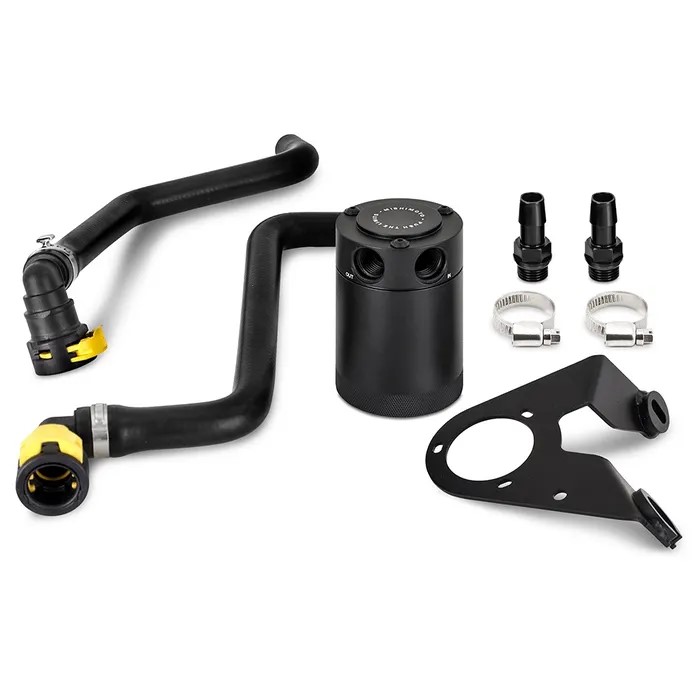Introduction to oil buildup and its effects on engine performance
Is your engine feeling sluggish lately? Are you experiencing a decrease in performance and fuel efficiency? If so, oil buildup could be to blame. Over time, engines accumulate oil residue that can clog vital components and hinder their functionality. This not only affects the overall performance of your vehicle but also leads to potential costly repairs down the line.
But fear not! There is a solution that can help prevent this issue from occurring – oil catch can kits with 6AN fittings. These handy devices work wonders in trapping excess oil vapor before it has a chance to contaminate your engine. In this blog post, we’ll explore the role of oil catch can kit and delve into why using 6AN fittings is crucial for optimal performance. So buckle up, because we’re about to dive deep into the world of engine maintenance!
Explanation of oil catch can kits and their purpose
Oil catch can kits are an essential component for maintaining the performance and longevity of your vehicle’s engine. But what exactly do they do? Let’s break it down.
Oil catch can kits are designed to prevent oil buildup in the intake system of your engine. As your engine operates, blow-by gases containing oil vapors are produced. Without a catch can, these oil vapors would be recirculated back into the combustion chambers, leading to carbon deposits and decreased performance over time.
By installing an oil catch can kit, you create a separate chamber where these oil vapors condense and collect before they have a chance to reach the intake system. This prevents them from coating vital components such as valves and intercoolers with oily residue.
The purpose of using 6AN fittings in oil catch can kits is to ensure proper flow and containment of collected oils. 6AN fittings provide a secure connection between hoses and components, preventing leaks or loss of collected oils during operation.
Using high-quality 6AN fittings also ensures the durability and longevity of the entire system. These fittings are specifically designed for automotive applications and offer excellent resistance to heat, pressure, vibration, and corrosion.
The importance of using 6AN fittings in oil catch can kits
When it comes to installing an oil catch can kit, one important aspect that shouldn’t be overlooked is the choice of fittings. Specifically, using 6AN fittings can make a significant difference in the overall performance and effectiveness of your oil catch can system.
The size and type of fittings used in an oil catch can kit play a crucial role in ensuring proper airflow and efficient separation of oil from crankcase vapors. The 6AN fitting size refers to a standardized measurement for hose connections that allows for optimal flow rates without causing restrictions or bottlenecks.
By using 6AN fittings in your oil catch can kit, you are ensuring that there is sufficient room for the passage of air and vapor through the system. This prevents any potential buildup or blockages that could impede its functionality.
Moreover, 6AN fittings are designed to provide a secure and leak-free connection between different components of the oil catch can system. They offer enhanced durability and reliability, reducing the risk of leaks or disconnections under high pressure or temperature conditions.
In addition to their functional benefits, using 6AN fittings also allows for greater flexibility when it comes to customization and upgrading your oil catch can setup. These fittings are widely available in various shapes and configurations, making it easier to adapt them to fit specific engine layouts or preferences.
Choosing 6AN fittings for your oil catch can kit is essential for maximizing its performance while minimizing any potential issues related to inadequate airflow or leakage. Investing in quality fittings will ensure that your engine remains protected from harmful contaminants while maintaining optimal efficiency throughout its lifespan.
Benefits of installing an oil catch can kit with 6AN fittings
Benefits of installing an oil catch can kit with 6AN fittings
When it comes to maintaining the performance and longevity of your engine, preventing oil buildup is crucial. One effective way to achieve this is by installing an oil catch can kit with 6AN fittings. But what exactly are the benefits of using such a system?
An oil catch can kit helps to minimize carbon build-up in your engine’s intake system. As the crankcase ventilation gases pass through the catch can, any excess oil and contaminants are trapped before they have a chance to enter the intake manifold. This not only improves overall engine efficiency but also keeps important components clean and functioning optimally.
Additionally, using 6AN fittings ensures a secure and leak-free connection between the various components of your oil catch can system. These fittings are specifically designed for high-pressure applications, providing peace of mind knowing that your setup will remain intact even under demanding conditions.
Furthermore, investing in an oil catch can kit with 6AN fittings will help extend the life of your engine. By reducing harmful deposits and contaminants from circulating throughout the combustion process, you’re effectively minimizing wear on vital moving parts. This translates into improved reliability and potentially significant cost savings down the line.
Installing an oil catch can kit with 6AN fittings is relatively easy and straightforward for those who enjoy DIY projects or prefer hands-on maintenance. With detailed instructions provided by most manufacturers along with readily available resources online, you’ll be able to set up your system efficiently without needing professional assistance.
In conclusion (not conclusive), installing an oil catch can kit equipped with 6AN fittings offers numerous benefits for both car enthusiasts and everyday drivers alike. From reducing carbon build-up to extending engine life span – it’s clear that this simple yet effective solution should not be overlooked when considering ways to protect your vehicle’s performance in the long run!
Maintenance tips for maintaining a functional oil catch can system
Maintenance Tips for Maintaining a Functional Oil Catch Can System
Proper maintenance of your oil catch can system is essential to ensure its optimal performance and longevity. Here are some important tips to keep in mind:
1. Regular Inspection: It’s crucial to inspect your oil catch can regularly, especially the fittings, hoses, and the canister itself. Look for any signs of leaks or blockages that may hinder the proper functioning of the system.
2. Emptying the Canister: The collected oil and contaminants in the catch can need to be emptied periodically. This frequency will depend on factors like driving conditions and engine usage. When emptying, make sure to dispose of it properly according to local regulations.
3. Cleaning: Over time, residue buildup may occur inside the catch canister and hoses. To prevent clogs and maintain efficiency, it’s recommended to clean these components with a suitable solvent or degreaser at regular intervals.
4. Check Fittings: Ensure that all 6AN fittings connecting your oil catch can kit are securely tightened without over-tightening them as this could damage threads or cause leaks.
5. Airflow Evaluation: Assess the airflow through the system regularly by removing hoses temporarily while running a vacuum test on each section separately – from the PCV valve connection point up into the intake manifold area (if applicable).
By following these maintenance tips, you’ll ensure that your oil catch can system continues performing effectively in preventing harmful buildup within your engine.
Alternatives to using an oil catch can kit
Alternatives to Using an Oil Catch Can Kit
While oil catch can kits with 6AN fittings are highly effective in preventing oil buildup, there are a few alternatives that you can consider if you’re not ready to invest in a kit just yet. One alternative is using a high-quality synthetic oil that is specifically designed to reduce carbon deposits and sludge formation. These oils have additives that help keep the engine clean, reducing the chances of oil buildup.
Another option is regular engine maintenance, including frequent oil changes and inspections. By sticking to the manufacturer’s recommended schedule for oil changes, you can minimize the risk of excessive oil accumulation in your engine. Additionally, inspecting and cleaning the PCV valve regularly will ensure proper ventilation and prevent excessive blow-by gases from entering the intake system.


0 Comments